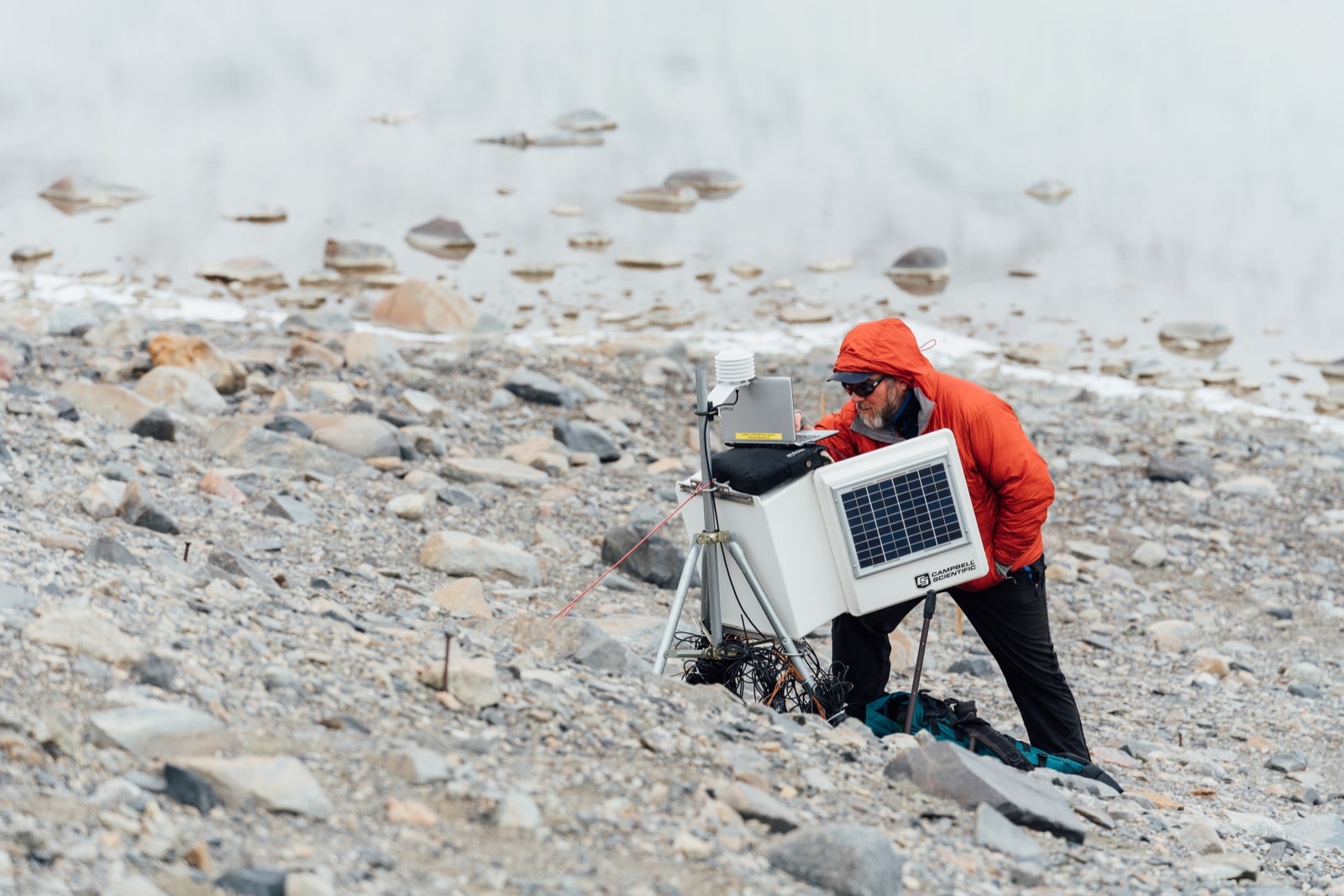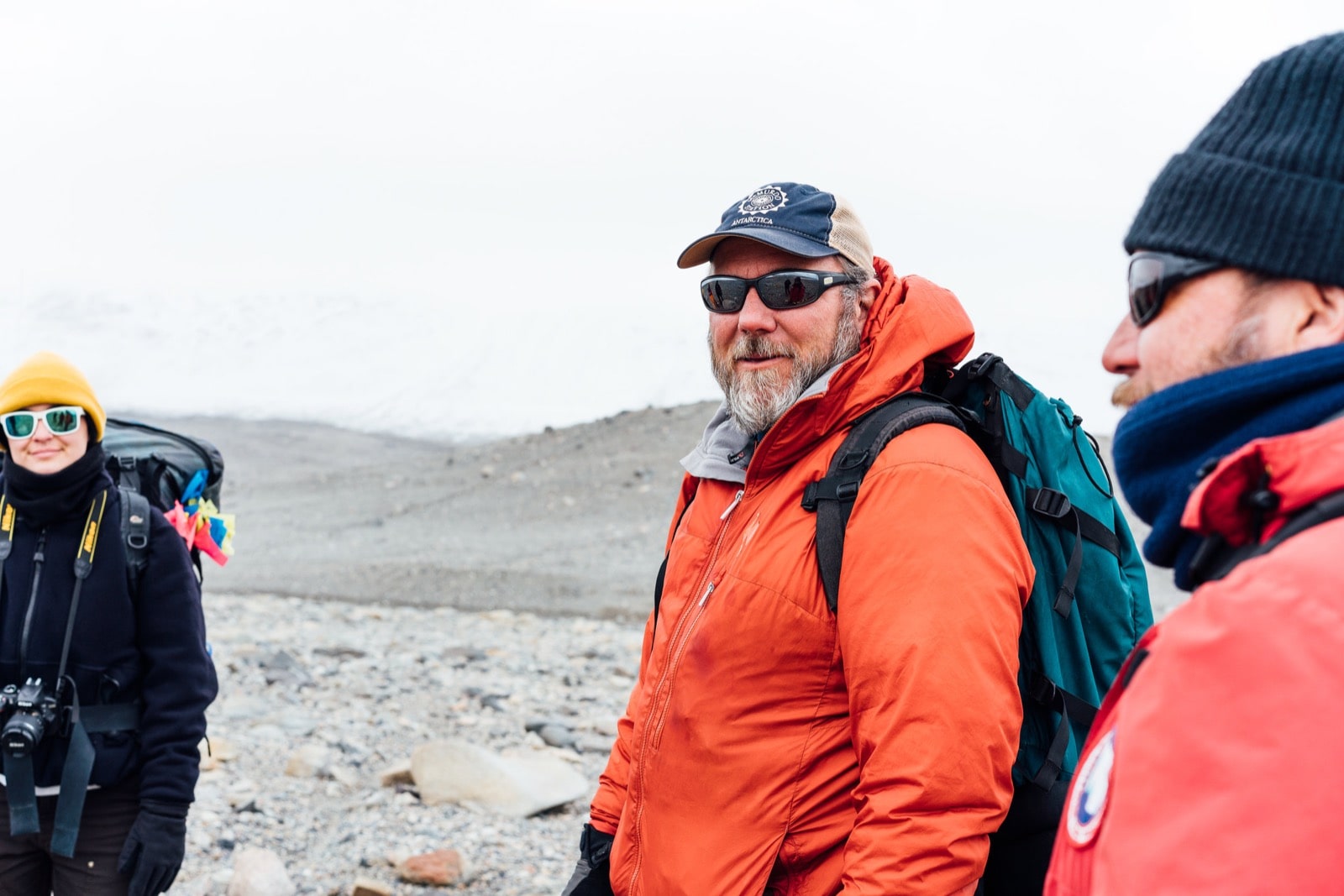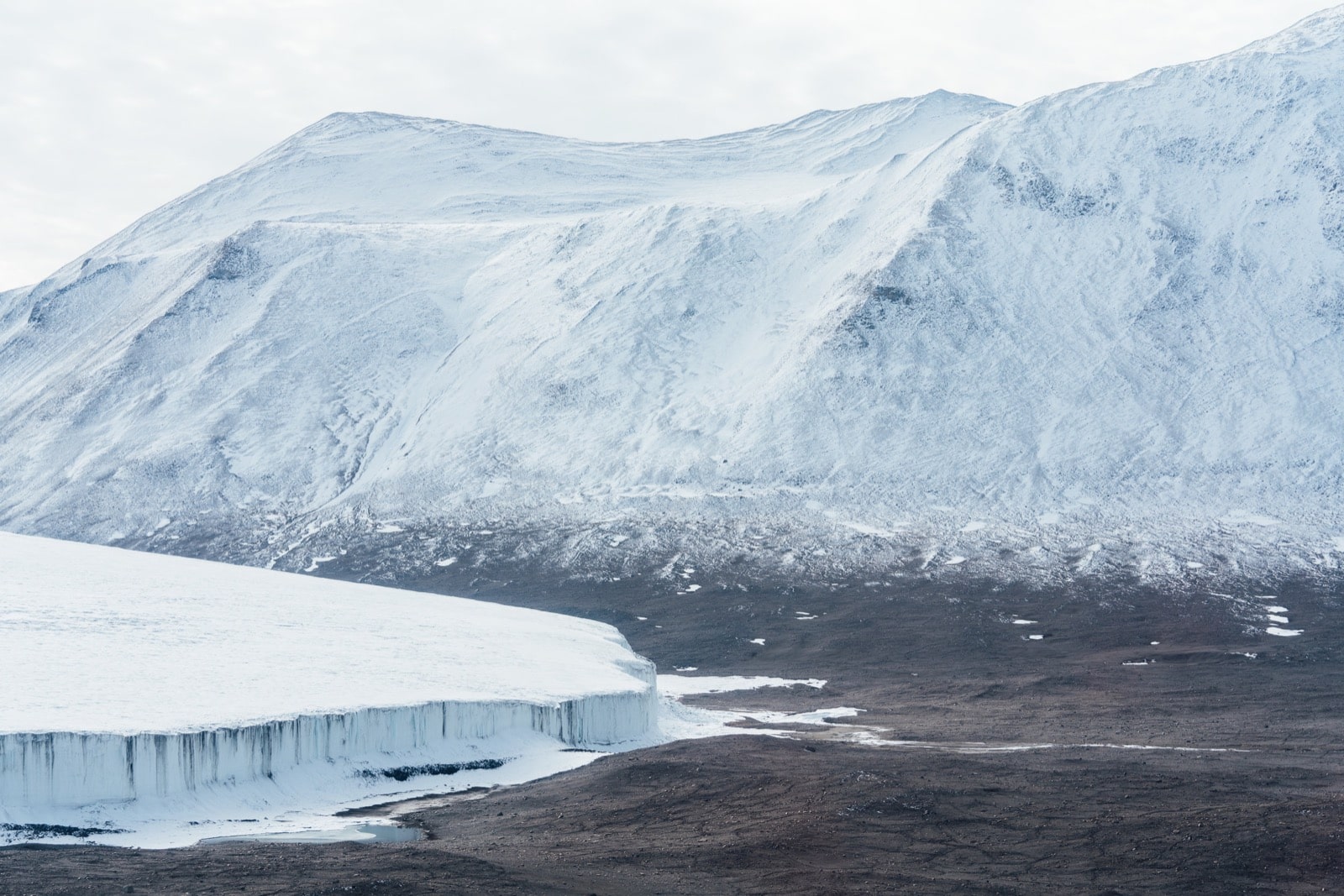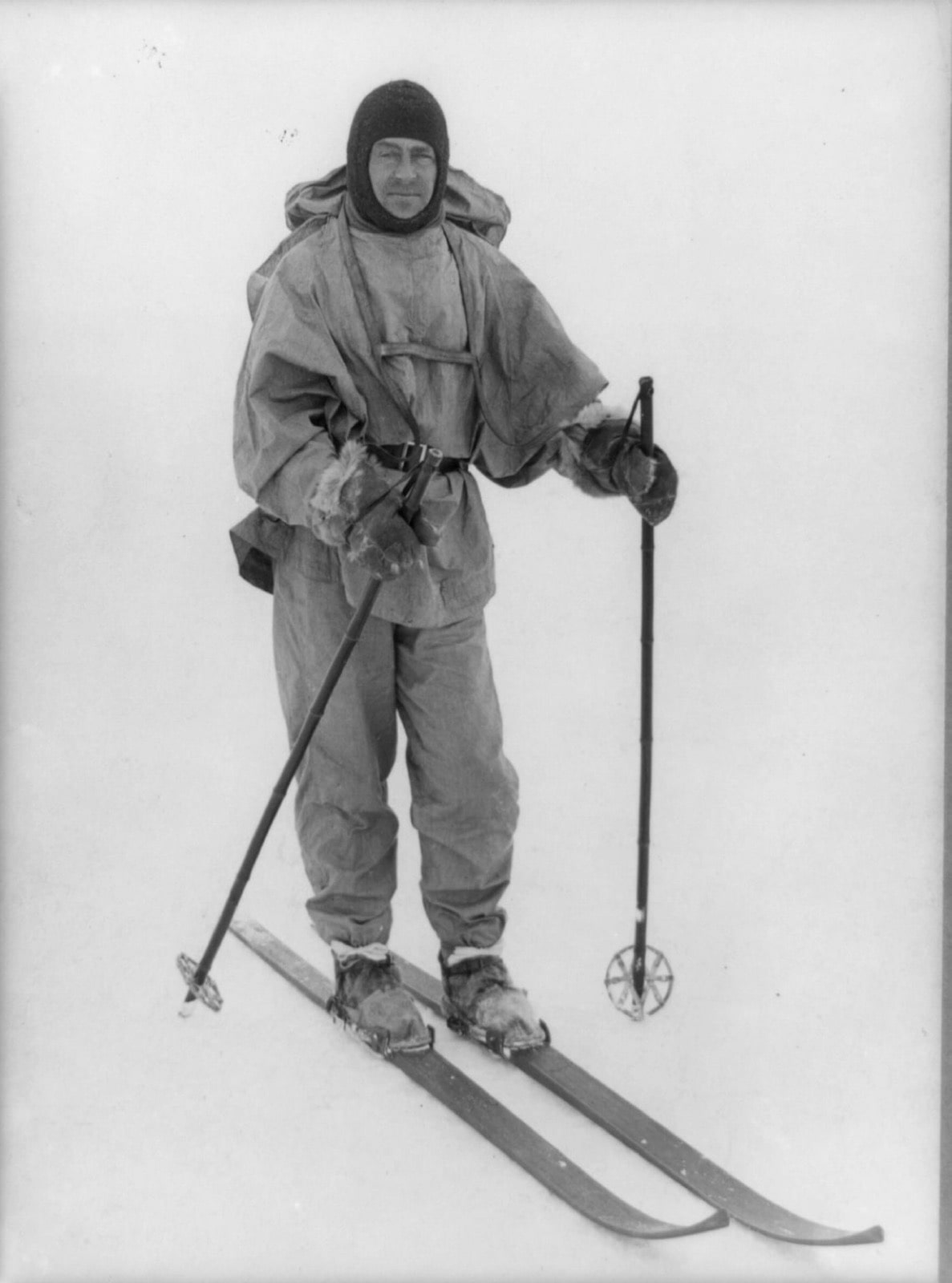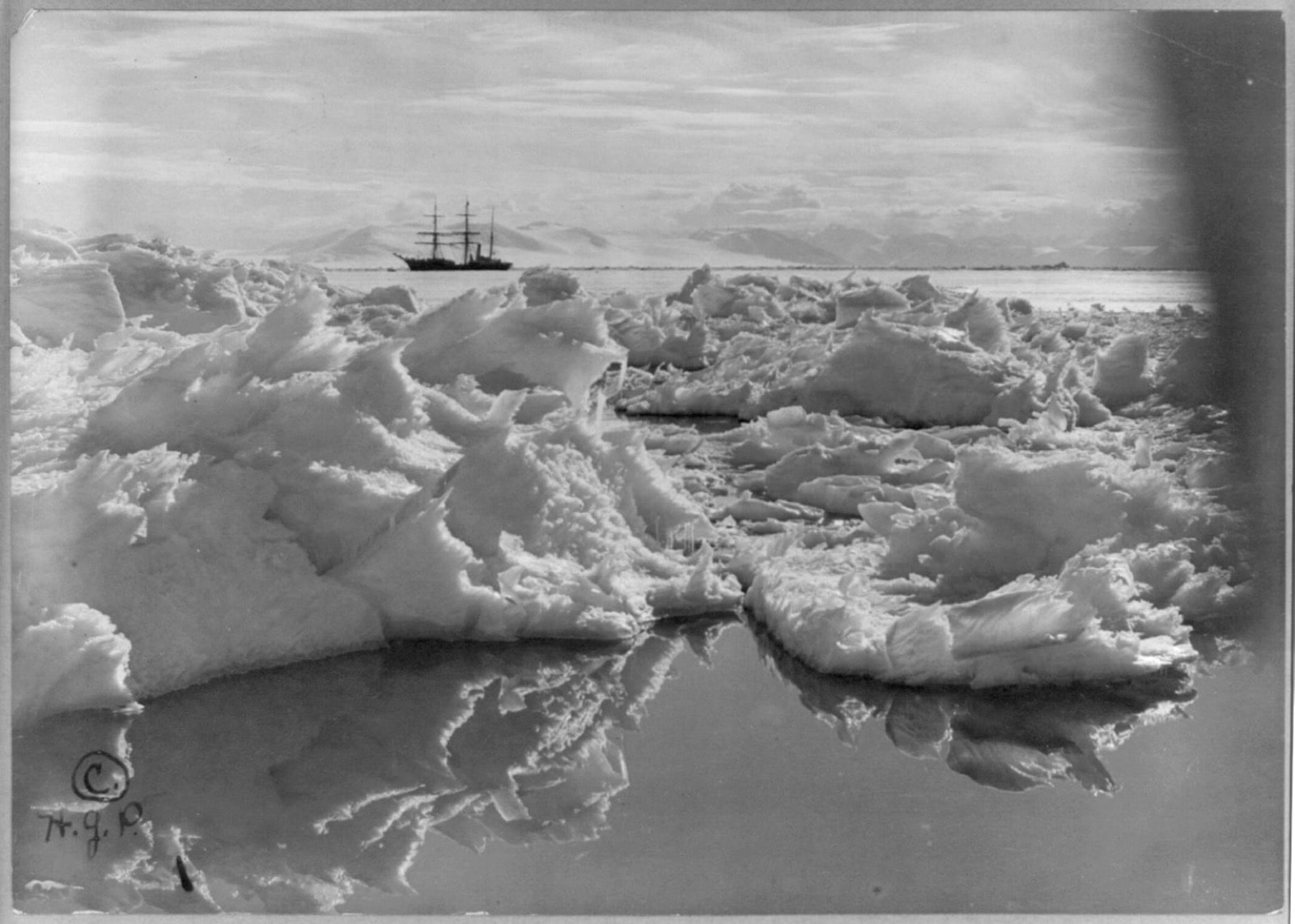Mike Gooseff cuts a swift, smooth path between wind-worn rocks in the dirt and sandy soil of a frozen desert.
Though just a 30-minute trek from the field hut basecamp, it looks like he’s hiking on Mars—a small glacier-fed stream to his left, a backdrop of rolling brown hills, and a low cloud ceiling that meets the horizon.
It’s beautifully barren, and the terrain looks like it has been undisturbed for millions of years.
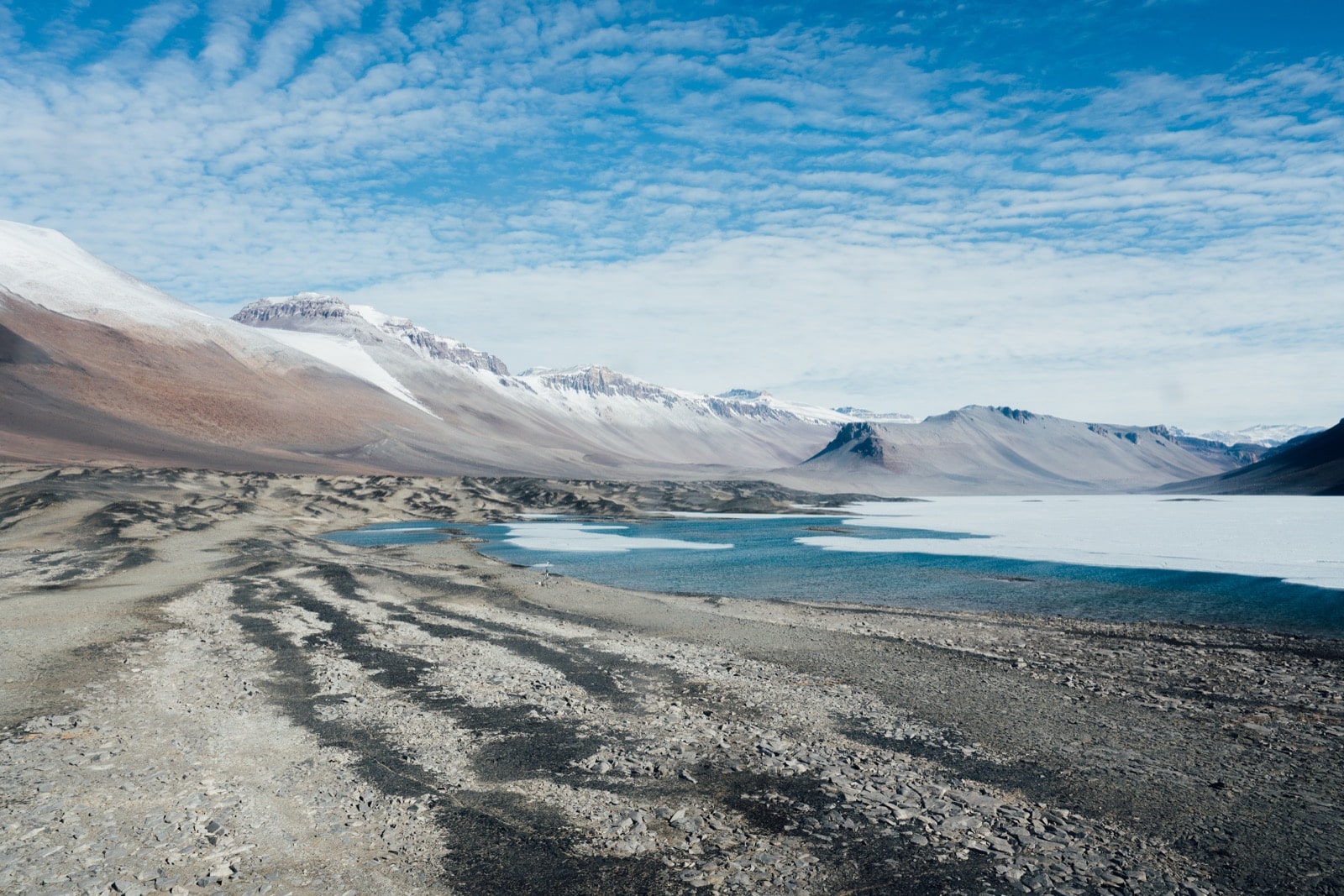
Lake Vanda in Wright Valley, one of the three largest valleys in the McMurdo Dry Valleys, Antarctica. Photo by Ariel Zych
Without much wind, there’s no discernible sound other than steady breathing and the swishing of heavy performance gear. But then Gooseff, sporting only a light down jacket and wind pants, suddenly stops. He points at the ground, his voice cutting through the stillness: “Whooaaaah, guys! Check out that algae!”
He’s staring at a waterlogged wash of sediment near the stream bed’s sagging wall. It’s blushing with emerald green algae. Anywhere else in the world, seeing a miniature mudslide wouldn’t be cause for much excitement. But this slump is like a distress signal for Gooseff, a hydrologist who’s been working for two decades in the McMurdo Dry Valleys, Antarctica—a pristine desert on the most isolated continent on Earth.
For the most part, freshwater in Antarctica should be frozen. Beneath the surface, water should be locked in a vault of ice sheets. But instead, all the water, salt, and nutrients unleashed from the stream’s muddy bank feed that green algae. The little freshwater that dribbles into the Dry Valleys melts down from the glaciers cupped high in the mountains that surround Gooseff’s research team. Glacier meltwater streams, like this one called Aiken Creek, only flow for 8 to 10 weeks at the height of summer each year, running through frozen troughs into lakes on the valley floor.
Mike Gooseff’s quick pace can be difficult to keep up with as he hikes between field sites. Gooseff is the lead principal investigator for the McMurdo Dry Valleys Long-Term Ecological Research (LTER) Project. Photo by Ariel Zych
During the 60 or so years that researchers in the United States Antarctic Program have been observing the Dry Valleys, the streambeds rarely, if ever, shifted. Gooseff and the Antarctic scientists before him have taken elaborate stream topography measurements, and the data have told the same story: The frozen earth remained relatively constant, untainted by the changes in climate seen everywhere else on the planet.
But then, just in the past decade or so, a new narrative in the numbers emerged as the ground visibly softened in some places and the permanence of some streambeds faltered.
“When that [solar] radiation is hitting the ground, you’re warming up the ground more,” says Gooseff. “It’s warming up and primed to be eroded.”
The squishy, swampy patches are a classic example of a landscape feature called thermokarst, which is caused by permafrost thawing. Thermokarst is common in the wake of Arctic permafrost thawing on the opposite side of the planet—largely attributed to global warming—but wasn’t documented much in Antarctica. Finding isolated occurrences of the sloshy sediment is becoming the “new normal” in the Dry Valleys. Now, scientists are trying to diagnose what’s changing—whether the thawing permafrost and fuller streams are a sign that global warming has arrived in this Antarctic desert.
“We have to be careful about [saying] warming,” Gooseff cautions. “A lot of what we think we’re seeing is actually just more sunlight and fewer cloudy days, which is very hard to believe on a day like this.”
In January, during the peak of summer in the Southern Hemisphere, it’s still bitter cold—temperatures have dropped to well below freezing. But even with frigid ambient air temperatures, the sun’s rays can provide just enough energy to melt the glaciers in the surrounding peaks, forming streamlets that meander down into the bottom of the valley. The combination of the sun’s energy, glacial ice, freezing winds, cloud cover, and the reflectivity of ice and soil trapped in the Dry Valley glaciers dictates when water flows and when it freezes. That freeze-thaw cycle is the pulse of the Dry Valleys ecosystem.
In January, Science Friday went on a typical field day with the McMurdo Dry Valleys Long-Term Ecological Research Group's "Stream Team," the research group that monitors 17 stream gauges in the Dry Valleys throughout the austral summer. Stream Team technician Jade Lawrence (first photo) carries surveying equipment between streams to measure morphological changes. A wash of green filamentous algae in Aiken Creek (second photo) catches the attention of lead principal investigator Mike Gooseff (third photo), and is an important indicator of change in the system. Photos by Ariel Zych
In the century or so that scientists have sniffed around the peculiar McMurdo Dry Valleys—one of the strangest environments on the frozen continent, and by many measures, in the entire world—there’s been a growing reluctance to articulate what climate normalcy looks like here, and an even greater hesitancy to describe recent changes in the Dry Valleys’ climate as global warming.
“Directional warming trends are most pronounced in places like the Arctic and Antarctic Peninsula,” says Jeb Barrett, a soil biologist studying the Dry Valleys system. “I think where people waffle is that we don’t have a clear [warming] trend.”
The capricious witches’ brew of the Dry Valleys’ climate has repeatedly thrown curveballs at climatologists and atmospheric scientists. It’s not only difficult to document climate change here, but also challenging to communicate how that change may manifest.
“Climate change is not just as simple as directional continuous warming,” says Barrett.
Gooseff and Barrett are among a group of scientists, called the McMurdo Dry Valleys Long-Term Ecological Research group (LTER)—keepers of the longest continuously collected stream flow dataset in Antarctica. It’s a humble record. But the series of simple measurements tells the story of an Antarctic stream that has been recorded diligently for 50 years. As the record grows longer and changes to this system become more conspicuous, these record shepherds are poring over the data for clues of the culprit behind the recent changes in the McMurdo Dry Valleys.
Soaring towards the Wilson Piedmont Glacier and McMurdo Sound, this mountain range is the gateway into Wright Valley. Video by Ariel Zych
The Dry Valleys are a continental outlier.
Only accessed by helicopter today, the Dry Valleys comprise of a series of several troughs between mountain ranges that extend inland from McMurdo Sound. These valleys are sheltered from heavy snowfall by the high peaks and lie inland from the relentless whirlpool of winds that tears around mainland Antarctica. Covered in constant summer sun, the snowless valleys are etched with moody streams that go from frozen solid to gushing torrents in a matter of days.
“You know we open our tent doors and this is what we look at and it’s pretty awesome,” Gooseff says. “When you look across this landscape you don’t see much life.”
The perception is that life struggles here, and the organisms that do manage to thrive remain invisible to the untrained eye. Even early explorers noted the naked wasteland. In December 1903, when British Royal Navy officer Robert Falcon Scott and the Antarctic Discovery expedition first set foot in the southernmost valley of the three largest in the system, they described it as a “valley of the dead” for its lifeless, barren quality. Though the men had lived in and explored Antarctica for months on sleds, or sledges, they hadn’t encountered fresh liquid water.
“It is an extraordinary novelty in our sledging experience to find that one can get water by simply dipping it up,” wrote Scott in his memoir of the expedition. Scott and his research team measured the water, noting lake depth and stream output and mapping the topography.
The first data points from the Dry Valleys were laid down.
Lake and stream observations were recorded during other explorations of the valleys, including a geological party led by Thomas Griffith Taylor—a geologist with Scott’s ill-fated 1910-1911 Terra Nova expedition—whose name would later be given to the first valley Scott explored, Taylor Valley. But after Taylor’s visit, no one returned to the Dry Valleys for nearly a half century. Then in 1958, a polar scientist from New Zealand named Colin Bull, along with biologist Richard Barwick and two undergraduates, ventured one valley farther up the coast than Scott and Taylor—into the Wright Valley. There, Bull was transfixed by what he found.
“One of the most intriguing sights was of a tiny river meandering along the bottom of the valley,” wrote Bull. The long river flowed inland, entirely fed by glacial melt.
He and Barwick named the river the Onyx.
Bull’s fascination with the area’s hydrology grew in those first months he spent in Wright Valley in 1958 and 1959. Ten years later, setting up camp on the shores where the Onyx River drains into Lake Vanda, researchers from the New Zealand Antarctic Program would monitor the ebbs and flows of the Onyx River for more than 20 years. The New Zealand Dry Valleys researchers suspected that their long-running observations of the Onyx “recorded in great detail the persistent progress of global warming.”
But despite finding what looked like a striking warming trend in the Onyx River Record, New Zealand’s interest in the Dry Valleys began to wane. In 1992, the Onyx River monitoring program was terminated. However, nearby in Taylor Valley, a group of researchers with the U.S. Geological Survey had also been observing streams since 1987.
Founding member of the McMurdo Dry Valleys LTER, Diane McKnight in the field. Photo courtesy Diane McKnight
“We as a group recognized its importance,” says Diane McKnight, a limnologist and biogeochemist and one of the researchers in Taylor Valley in 1992. To their knowledge, “those flow records date back further than any meteorological data in the Dry Valleys.”
McKnight and fellow Antarctic researchers decided to help preserve the Onyx River Record. Just as New Zealand defunded the research group’s Onyx River observations, McKnight, along with colleagues from several institutions nationwide, received funding to establish a Long-Term Ecological Research outpost in the McMurdo Dry Valleys. For four years, the LTER worked with New Zealand researchers and assumed responsibility of the Onyx River Record.
“There’s a lot that comes with it and stepping up to the plate is giant,” says McKnight, now a founding member and principal investigator of the McMurdo Dry Valleys LTER, who for years managed most of the funding, collaboration, training, and fieldwork necessary to monitor the Onyx during the melt season. "It's just a lot of mental energy... and care to have a high-quality record, to have it be what it could be.”
The Onyx River bends and weaves across the bottom of Wright Valley. Video by Ariel Zych
As the clouds clear over Taylor Valley, Gooseff and a team of field technicians fly to the Onyx River.
It’s dark and deafening inside the Bell 212 helicopter on the 30-minute flight into Wright Valley, but everyone is mesmerized by the view out the scratched windows. Below, a waterway glistens gold under the sun for miles across the expansive dull valley floor.
The Onyx River looks much more like a stream than a river, reaching just 50 feet across at most. In spite of its diminutive width, it’s Antarctica’s Mississippi, passing over about 20 miles on its path from Wright Glacier on the McMurdo Sound coast inland to Lake Vanda.
“If you aren’t impressed by this place, then you’re impossible to impress,” says Gooseff. He’s right.
Stream technician Jade Lawrence measures stream flow in the Onyx River at one of two sites monitored continuously for nearly 50 years. Video by Ariel Zych
This river is a researcher’s dream. There’s little significant precipitation in the Dry Valleys. Instead, the Onyx River is fed exclusively by glacier melt. There are no green, leafy plants or trees to soak up water, no construction or deforestation disturbances to the ground, and very little human presence. This combination of factors makes the Onyx so valuable as a proxy for climate: It’s clean and dependable.
“This is my favorite river,” says Gooseff, smiling in the January sun. “It always flows a lot; you can always make a nice wading measurement going all the way across the river.”
The team lands a quick stroll away from the Onyx, and there’s a small white box that houses the automated monitoring equipment that collects data from sensors resting in the stream near a short sandbag dam called a weir. Two technicians wade into the shallow trickling stream, recording flow, depth, conductivity, dissolved oxygen, and algal activity at various positions along the water. Everyone is in good spirits, including Gooseff.
"If I could hug a river, I would want to be able to hug this one. The Onyx River rocks.”
The work is nothing fancy, and in fact the whole effort aside from the helicopter ride seems spartan. But the team’s data add to the one of the longest-running records of climate in Antarctica—building upon the century-old measurements of the stream’s flow made by the likes of Scott, Taylor, and Bull. The Onyx River Record’s historical, continuous collection is what led scientists to understand a bizarre climate trend beginning in the 1980s. While the rest of the world was warming, for more than 30 years, the Dry Valleys and much of Antarctica appeared to be cooling down.
“If I could hug a river, I would want to be able to hug this one. The Onyx River rocks.”
In January 2002, falling temperatures and a flood changed everything. In a paper published in the journal Nature, 13 researchers from the LTER showed that from 1966 to 2000, much of Antarctica had experienced a net cooling trend. Even as the Antarctic Peninsula—the long tail of land that reaches into higher latitudes—had warmed significantly, the expansive interior of the continent including the Dry Valleys had measurably cooled despite evidence of increased solar radiation. McKnight, a co-author on the paper, takes a deep breath and sighs. “This paper created a lot of controversy.”
When the cooling-trend paper was first published, it was weaponized by climate deniers, misunderstood by the general public, and became kindling for a press fire. The findings ran contrary to nearly every assessment of global temperatures for the same time period worldwide, arriving like a pack of cigarettes at a smoking-cessation workshop. Depending on who you asked, the results were either maddeningly frustrating or manna from heaven.
This shows the annual progression of ozone over the Southern Hemisphere from 1979 to 2018 recorded every November. The deeper blues and purples indicate where there is the least amount of ozone, while yellows and reds show where levels are the highest. Video by NASA Ozone Watch
The meteorological data were analyzed by a broader community of climatologists and atmospheric scientists who eventually attributed the cooling period to a continental climate phenomenon—a circumpolar vortex.
The circumpolar vortex, or polar vortex, is like a giant refrigerator for most of continental Antarctica, constantly churning strong, cold winds. But the circumpolar winds that keep the continent cool had gone into overdrive.
“Atmospheric scientists were able to show that the absence of ozone in this period in the spring contributes to a strengthening of [the circumpolar] vortex, the winds that circle over Antarctica,” says McKnight. “Those winds persisted longer into the summer, keeping the continent colder.”
This opening in the ozone was caused by the widespread use of chlorofluorocarbons (CFCs), a now-banned class of ozone-depleting chemicals in consumer aerosol sprays and other products. The growing hole in the ozone layer that seasonally spreads over the Antarctic continent led directly to the three decades of cooling seen in the Dry Valleys.
“So there are very clear climate change impacts on ecological systems in the Arctic and out on the Antarctic Peninsula,” says Byron Adams, the lead principal investigator of the soils team that studies the distribution of nematodes and other microorganisms in the Dry Valleys. The Antarctic Peninsula lies outside of this chilling vortex and has suffered the effects of a warming globe. But in the Dry Valleys, “we’re so far into the interior part of Antarctica that the circumpolar vortex is kind of insulating us from those sorts of [warming] effects,” he says.
The Antarctic Sun January 20, 2002 issue. The Antarctic Sun is published by the National Science Foundation-managed U.S. Antarctic Program. Reproduced with permission.
By the time the researchers could explain the mechanism of the cooling trend, the damage had been done. Then, around 2001, 2002, the ozone hole began to heal, causing those chilling winds to subside. Paradoxically, days after the paper’s publication, the McMurdo Dry Valleys experienced the largest melt event of the past half century.
“There’s this great article, the cover of the Antarctic Sun, that reports on the Nature paper, you know,” McKnight says. Splashed across the front page of the local paper was the headline, “The Ice cools as world warms.” Immediately to the left was a second article titled, “Heat wave melts ice, floods valleys,” she explains.
It was the ultimate irony: On the heels of a highly controversial consistent period of cooling, the Dry Valleys experienced its sunniest, meltiest year on record. The LTER plotted record-high flows in streams throughout the Taylor and Wright Valleys. Though the whole melting event only lasted about three weeks, Dry Valleys researchers dubbed it “the flood year”—a flow year that ushered in a new climate era there.
The rigid, frozen landscape had fallen apart in a little more than a fortnight. Soil plots had been covered by marshland. Stakes and weirs had been buried in silt carried by the force of torrential stream flows. As the McMurdo LTER research teams began piecing their observation regime back together, they noticed a dramatic change of direction in trendlines. Stream algae, stream flow, soil biota, solar-energy input—multiple variables had flipped direction. It was as if the flood year had built a whole new ecosystem.
“I started to see these things kind of moving in different directions at different rates and different spatial scales,” Adams says. “We were all set up to try to disentangle that, or at least try and make sense of it.”
Several biological and environmental trends observed by the McMurdo LTER project since 1990 shifted in the decade following the flood year in 2002. Annual stream flow began increasing (for example, Fryxell stream, 10⁶x m³); lake ice thickness began thinning (Eastern Lake Bonney, m); nematodes in the genus Scottnema became more abundant (Lake Hoare’s long-term monitoring site, number of individuals/kg dry soil); black algae was more productive (Eastern Lake Bonney, ash free dry mass mg/cm²); primary productivity, a measure of photosynthesis by aquatic algae, began increasing (Eastern Lake Bonney, corrected for depth, mgC/m²/d). Data represent a subset of those presented in Figure 2 from Gooseff et al 2017, and are available for download. Data design by Ariel Zych in Tableau Public
From 2002 to 2013, the researchers carefully logged ecological and physical responses to the flood year. It was during this time that Gooseff and others first started documenting thermokarst from radical permafrost degradation, thinning of the ice on the surface of lakes, and an increase in the abundance of nematodes in soil samples, which could indicate more available nutrients and more water.
"The beauty of the Onyx Record is that at least it tells us, going all the way back to ’69, [that] these are the highest flows we saw, that have been experienced in this area, for almost 50 years,” says Gooseff, “and that’s what makes this flood year stand out.”
“We had the sense that we were witnessing something unexpected,” says McKnight. “We didn’t know if it was just a singular event or if it would be a harbinger of change beyond this cooling trend.”
“The beauty of the Onyx Record is that at least it tells us, going all the way back to ‘69, [that] these are the highest flows we saw, that have been experienced in this area, for almost 50 years.”
The Onyx River Record allowed members of Diane McKnight’s research group to separate the relatively short-lived cooling effects of the ozone hole from the longer-term influences of global warming. Reaching back in time, her research group used the Onyx River Record to compare contemporary stream flow and the corresponding lake levels with those documented more than a century earlier during those first expeditions in the 1900s. Before the ozone hole opened the floodgates, the flows were likely increasing by about 4% per year between 1903 and 1970, according to the group’s 2001 study.
“From that we figured out that the flows must have been rising over that period of time,” says McKnight.
Increased flows mean increased glacial melt, she says. Analysis of the Onyx River Record had shown that a wider, centuries-long trend of glacier melting had preceded the controversial cooling trend that had brought with it so much grief.
The mouth of the Onyx River at Lake Vanda, and New Zealand's Lake Vanda Hut. Video by Ariel Zych
By 2017, the impacts and broader implications of the flood year had become clear.
The Onyx River Record provided evidence not only of the magnitude of the 2002 melt event, but a measure of the change in water availability in the Dry Valleys since. With a decade of data now at its disposal, the LTER team published a paper in 2017 documenting the arsenal of changes witnessed in the Dry Valleys following the flood year.
“For me, the 2017 paper showed that we kept going as a team,” after the data debacle of 2002, says McKnight. “I was excited and proud that our team had evolved and we were still thinking in this holistic manner about the Dry Valleys changing.”
But scientists who want to wield the record to further study whether climate change is truly happening in the Dry Valleys know doing so comes with risks. Like all federally funded initiatives, the LTER is under perennial threat of being shut down for a myriad of reasons—from dwindling interest and limited funds to concern of politicization. There is a constant fear that the LTER, like any climate-related research, could be politicized.
“In our last proposal we had lots of discussions about how much we should walk away from language about climate change,” Barrett says. “Even at the risk of not being funded, I think we need to be honest about what we’re doing.”
All 28 LTER sites have to propose novel experiments and monitoring approaches every six years or face termination—a fate that could rattle the band of researchers preserving the legacy of long-term studies worldwide. "Sometimes in this network of long-term ecological research sites, when one of them fails or is terminated, it’s very traumatic not just for that team as it’s evolved, but for the community overall,” says McKnight.
Apathy may pose a bigger threat to this work. Interest in long-term research can fade before scientists can even get close to publishing results. (When a single Antarctic nematode worm takes seven years to complete its life cycle, it can be years before any of those changes can be interpreted as a trend.)
“A lot of what we’re doing is collecting data that can answer questions that have not been asked yet,” says Byron Adams, the soil scientist studying nematodes. “This is why we’re going to collect these data.”
It was what the LTER program was always designed to do: Observe the types of phenomena that stretch and twist over long spans of time.
Without the data that had already been collected, the biggest melting event in the history of the region could have gone unseen. Without the Onyx River Record, the flood year could never have been used to make sense of massive global phenomena like permafrost stability and ozone holes, ecosystem shifts and climate change. Still, the value hidden within basic, long-term research seems so far-reaching, so unfathomable. The pursuit becomes an act of perseverance, carried on by a team of close-knit colleagues in the coldest desert on the planet.
“It’s a lot of commitment,” McKnight says. “But it’s totally worth it.”
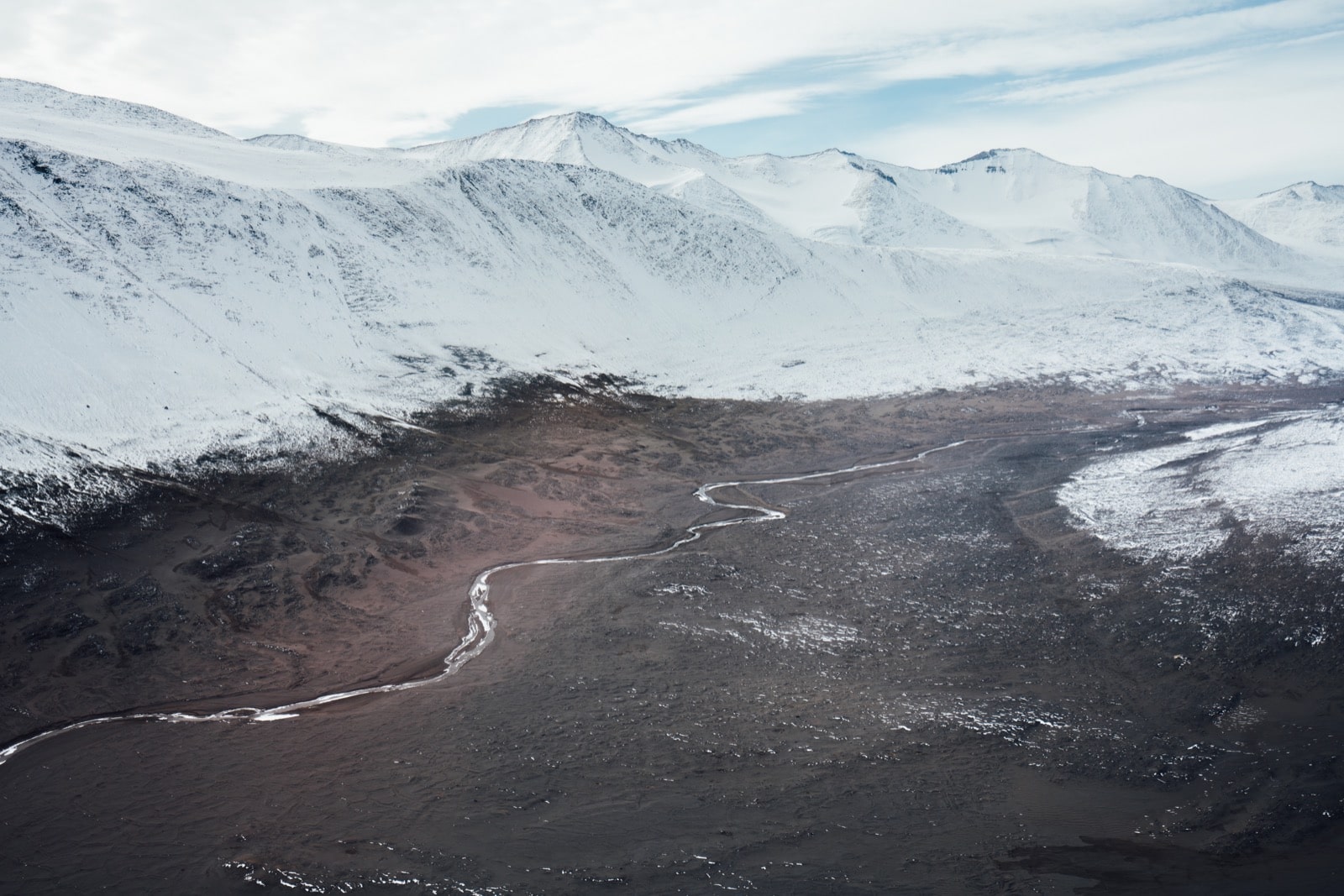
Onyx River, Wright Valley, Antarctica. Photo by Ariel Zych
Our methods
Why Is This A Story Worth Telling?
It is easy to forget how much work it takes to document climate change. It’s easier to assume that climate change is as simple as unseasonably warm temperatures. But in isolated parts of the planet, like the Dry Valleys of Antarctica, climate gets a little complicated and change is difficult to document. Through a half-century of continuous, basic research, scientists in Antarctica have managed to document a much more nuanced climate story—one influenced by not one, but two anthropogenic pressures. It isn’t a clean-cut climate change parable, but a reminder of the care and persistence required to untangle multiple environmental variables and field logistics to better understand our planet.
How Did We Report This Piece?
We traveled to Christchurch, New Zealand, McMurdo Station, Antarctica, and the McMurdo Dry Valleys for three weeks of field reporting in January 2019. Over the course of reporting this piece, we spoke with 11 research scientists, six graduate students, and seven contract employees at their home institutions and in the field. To piece together the history of the Onyx River Record, we drew upon multiple primary research publications, biographies, and regional histories of early expeditions.
Further Reading
Listen to Ariel Zych and principal investigator Diane McKnight tell the story of the Dry Valleys on Science Friday.
Experience what it’s like to be an Antarctic explorer by reading Robert Falcon Scott’s retelling of his first expedition to Antarctica in The Voyage Of The Discovery and Colin Bull’s colorful account of his exploration of the Dry Valleys in Innocents In The Dry Valleys.
Hear Science Friday take a call from an Adélie penguin colony in Antarctica.
Listen to climate scientist Eric Rignot explain on Science Friday why Antarctica’s ice sheet is melting more quickly than previously thought.
Learn more about how scientists are studying subsurface water in the Dry Valleys in this article from the Wall Street Journal.
Model ice-shelf glacier interactions with sea level rise using flubber in a hands-on education activity on Science Friday.
Credits
Written, reported, and photographed by Ariel Zych
Edited by Lauren J. Young
Site design by Daniel Peterschmidt
Fact checking and copy editing by Michele Berger
Special thanks to Brandon Echter, Johanna Mayer, Christian Skotte, Danielle Dana, Jen Fenwick, Valissa Mayers, and the rest of the Science Friday staff. Thanks also to Mike Lucibella and Peter West for their essential logistics support during the field reporting process.
Northwestern University Knight Lab's free tool SoundCite and Tableau Public's free data visualiztion software were used in the making of this project.
Ariel Zych traveled with support from the National Science Foundation’s United States Antarctic Program. Research for this story began months prior to receiving support from the National Science Foundation. The National Science Foundation, its contractors, grantees, and affiliates exerted no editorial influence during the reporting, writing, editing, or publishing of this article pursuant with Science Friday’s underwriting policy.
Published June 6, 2019




